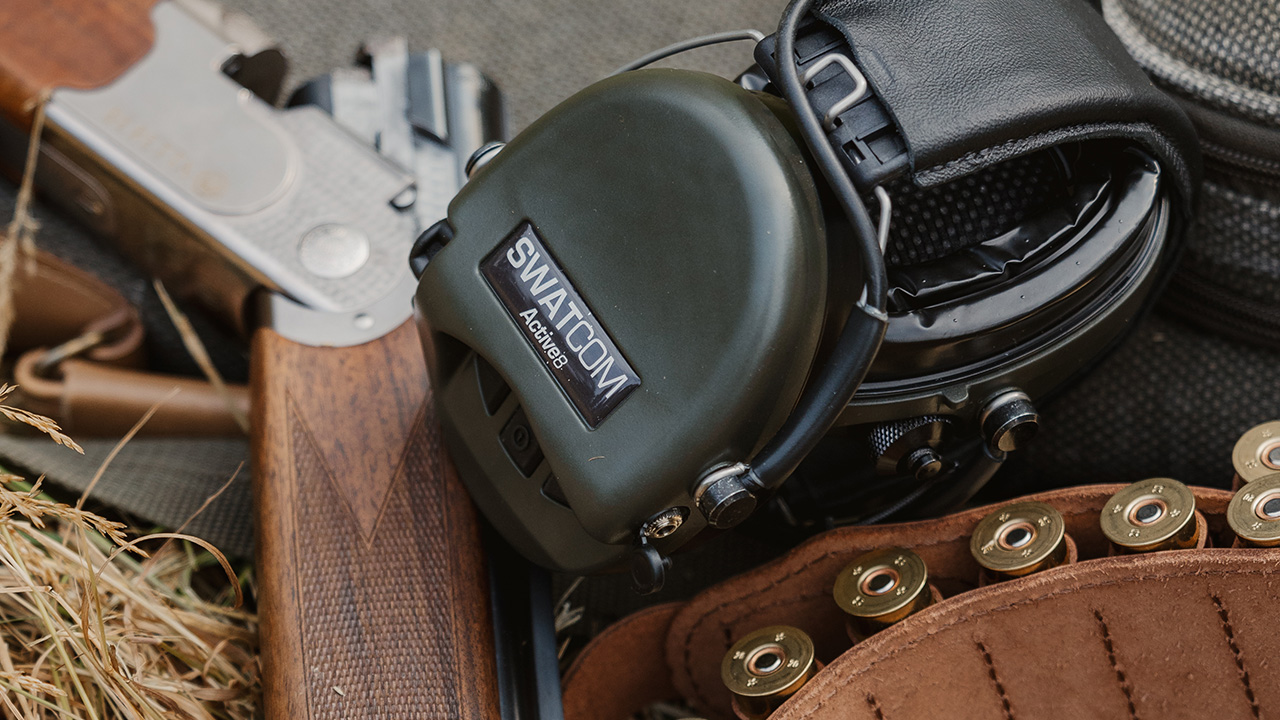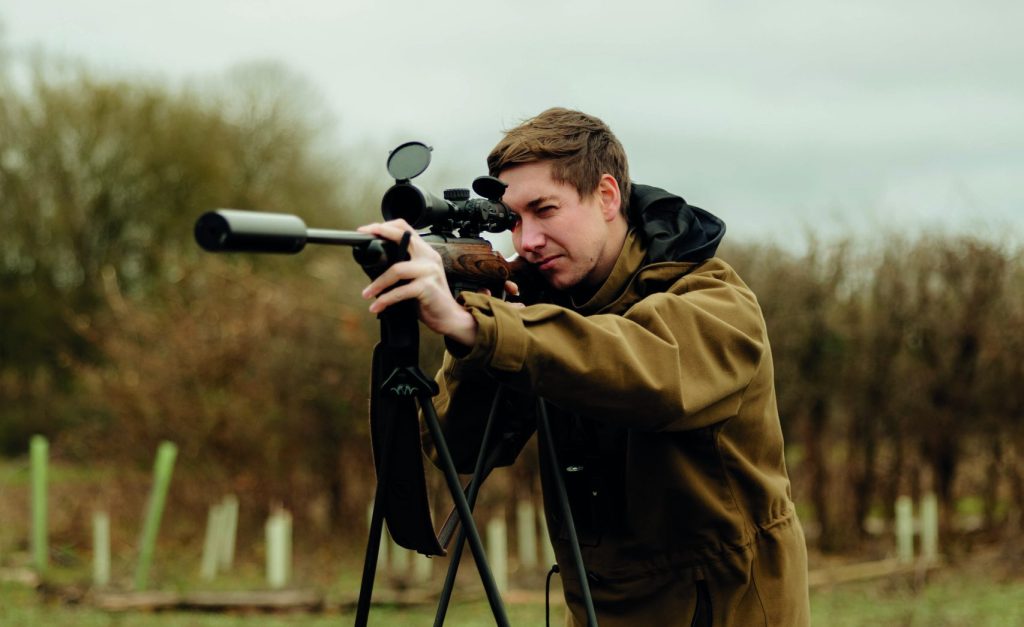Nile buffalo
An unforgettable big game hunt in the shadow of Uganda’s Mount Elgon.

Having stealthily crawled to within 30 yards of the group, our faint scent was carried on swirling midday winds to the herd which subsequently revealed itself to be far bigger than we had thought. No less than 130 Nile buffalo hurtled off with drama and speed, mercifully in the other direction to us. This seismic act signalled the game was up for the morning. It was getting on for 12pm and the heat was visible, emanating off the ground in waves.
We’d all but turned back to head for camp when I heard a sharp inhalation from Gareth. “Stop” he whispered, as he slowly crouched down, indicating I should do the same. “Under those trees. Two bulls.” I followed Gareth’s lead as he made his way, quick and low, from tree to tree, to get close enough for a look. Would they be the right age? Would we get a shot? My adrenalin was creeping up again, while the humidity and temperature was making me wheeze. We paused under a thornbush tree where we finally had a decent view of their bulk, unobstructed by long grass from midway up.
This hunt, this place, was a major dream come true, for we were hunting Nile buffalo in the shadow of Mount Elgon, one of East Africa’s great mountains. This was the Karamoja region of Uganda where my boyhood hero, Walter Dalrymple Maitland Bell, had gained his moniker of ‘Karamojo Bell’. I have read and re-read his adventures, for what young hunter wouldn’t be inspired by this Scottish adventurer who was soldier, fighter pilot, sailor, writer, painter and big-game hunter? W. D. M. Bell’s writings have had a lasting effect on me and are a huge contributing factor to why I do what I do. So to be hunting dangerous game on the hallowed ground that he likely walked and hunted (he said he walked an average of 73 miles for every elephant he shot) was inspiring and intimidating all at once.
I’d been hunting plains game during my stay, but while I’d hunted Cape buffalo in other African countries, Nile buffalo was something I hadn’t yet had the chance to pursue. While Bell almost certainly would have used a .275 Rigby, famously preferring smaller calibres to hunt with, this is no longer allowed as it is just too risky for dangerous game. So a .416 Rigby Big Game rifle was chosen, a rifle I knew and trusted having used it on Cape buffalo before. I knew too, from my lessons a few years ago with ‘The Doctor’ (Kevin Doctari Robertson), that a shot at buffalo is not to be taken lightly. In his words: “It starts a war, someone or something is going to die as soon as that first shot goes off”. The pressure was on. We’d had several near chances over the past week at single buffalo in thick stuff, but as so often happens with a hunting trip, a suitable old bull – our main objective – had remained just out of reach.
For a number of days I hunted with PH Gareth Lecluse in the PiaNupe Wildlife Reserve, where Karimojong Overland Safaris (KOS) had gained the concession for sport hunting just seven years ago with express permission from the President of Uganda. Subsequently, thanks to sport hunting, the area has undergone a remarkable transformation and is a great showcase for the argument that hunting can and does help restore and preserve wildlife. Our camp was rustic but comfortable, and the perfect jumping off point for hunting all manner of plains game, some of which – notably the South Sudan Roan – is unique to the area and cannot be legally hunted anywhere else in the world.
We had a close encounter two day’s previously, tracking a large herd by a river and closing in well, however we were unable to make that final advance to identify a good old bull before they blew out. The problem with big herds is that there are always outliers and so many eyes, ears and noses to pick up predators. A huge herd had been spotted feeding at night in the shadow out Mount Kadam in the Debasien range, an area Bell refers to in his books. Starting at first light we bounced our way across the open country in the vehicle to get close enough for tracking. No one said much over the roar of the engine, the tension tangible – hope, nerves and expectations all bound up in this expedition.
Gareth skidded to a halt just as the light was starting to break. “On foot now. Check everything,” he said as I got out, my teeth feeling like they’d been rattled loose from the ride. I loaded the rifle with three 400 grain Hornady Dangerous Game Solid cartridges then a soft or ‘DGX’ of the same weight on top. I checked I had spare ammunition on my belt – carry as much as you can is the mantra I know works for buffalo. After grabbing the sticks from the vehicle the three of us set off at a steady pace. “They’re moving. We’re lucky it rained last night, it has given us brilliant tracks,” he explained. I followed behind him, looking as he did at the ground to see the marks animals had left everywhere around us. It takes someone with huge experience and knowledge to be able to make sense of spoor from a herd which seemed to lead in every direction. We didn’t hang about, Gareth walking at a good pace to catch up to the herd while it was still cool.
The country we were in was very open and cover was very sparse – while the long grass wasn’t enough to offer cover it also meant it would be hard to spot animals until you were almost on top of them. Worse still, getting a clear, clean shot is definitely less straightforward. Dotted in the long grass are the thornbush trees which cast a little shade, and as we neared the area the herd was in, we started moving between these and using them for cover. Moving quickly and silently we had closed in on the herd. “We’re now about 800 yards away from them,” whispered Gareth. “We need, somehow, to close that distance.” He paused while deciding how to proceed. There was a breeze – not much, but just enough to ruin this if we didn’t take precautions. We would have to loop around the herd tripling our approach distance, but it meant we’d be in with a chance. We set off moving carefully, now in the stop-start, slow-fast movement of a final approach familiar to anyone who hunts. Trying to keep my breathing steady and deep, not to let my adrenalin, nerves and excitement take over, I focused on following exactly in Gareth’s footsteps.
We’d managed our loop and now, unbelievably, were downwind of the herd and within spitting distance of being in range. Just 40 yards or so would do it. Gareth turned to me and indicated to get low. “Bum shuffle,” he said in a hushed voice. I laid the rifle across my lap, and copied his movements, hoiking myself forward with my legs and hands. We started closing the distance. Thirty yards. Twenty. Gareth paused for a beat, scanning the ground ahead of us before moving forwards again. I felt the vibrations before I heard the herd. They had bolted. Whether there was an outlier close than we’d realised or, maybe, they were spooked by us or something else, I don’t know, but our chance was dashed. The adrenalin that had been coursing through my veins vanished, and I felt exhausted, drained and disappointed. We stood, watching the huge herd heading off away from us. They weren’t stampeding, but they were moving too fast for us to catch up to them.
As we turned to make our way back to the vehicle, Gareth looked every bit as disappointed as I felt. We started to walk, but within two steps, Gareth dropped, and indicated for me to do the same. Slowly, cautiously, he grabbed his binoculars and scanned the ground to one side. “Under that tree. Two bulls, mature, 400 yards,” he whispered, pointing. I could just about see them. For some reason, these two hadn’t moved off with the rest of the herd. In double quick time, we closed in on them. There was not a second to lose for at any moment they could decide to join the rest of the animals.
We closed in enough to give me a shot with the express sights of the Rigby. One bull was facing us, the other faced away. “Take the one facing us,” Gareth instructed. I steadied myself, trying to drown out the thudding of my heart, trying to still the shaking of my hands. I was attempting this 100-yard shot with open sights – a very different business to optics. Breathing deeply a few times and gently squeezing did the trick and the boom of the rifle took me by surprise. I worked the bolt and reloaded. The two bulls moved off, not fast, but enough to make it a bit trickier. My bull was in the lead, quartering away. My training with The Doctor took over and Gareth told me to take him again. I fired for a second time, putting another fatal shot with a solid through the length of the bull from haunch through to front left scapular. The two bulls moved forward again, slower this time. After 50 or so yards, they stopped under the shade of a tree.
Related Articles
Get the latest news delivered direct to your door
Subscribe to Fieldsports Journal
Elevate your experience in the field with a subscription to Fieldsports Journal, the premium publication for passionate country sports enthusiasts. This bi-monthly journal delivers unparalleled coverage of game shooting, fishing and big game across the UK and beyond.
Each issue offers a stunning collection of in-depth features, expert opinions and world-class photography, all presented in a timeless yet contemporary design.
Save 10% on shop price when you subscribe, with a choice of packages that work for you. Choose from Print & Digital or Digital only with each journal delivered directly to your door or via the app every other month, plus access to past issues with the digital back issue library.











